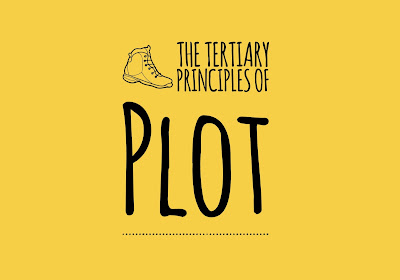In storytelling, the primary principles of plot include goal, antagonist, conflict, and consequences. You can't have a great plot without those elements first. The secondary principles of plot build directly off the primary, and they include progress, setbacks, costs, and turning points. As you likely guessed, the tertiary principles build off the prior two sets, and they include plans, gaps, and crises.
Here is a very brief review of what we've covered so far.
Goal--the protagonist has a want that manifests in a concrete goal. (There are different types of goals and the goal may change, but a goal is necessary to create context for the plot.)
Antagonist--the antagonistic force is a form of opposition; and thus it is something in the way of the goal. (While there is often a primary antagonist, most stories will have multiple--and even temporary--antagonistic forces)
Conflict--because the protagonist and antagonist "want" opposing things (to some degree), this leads to conflict.
Consequences--conflict only really matters when it carries consequences. This gives a plot a sense of cause and effect. Stakes appear as potential consequences. Ramifications appear as consequences that actually happen.
Progress--progress is used to measure how close the protagonist is to getting the goal. A sense of progress comes from reaching smaller goals within the larger goal.
Setbacks--setbacks happen when an antagonistic force blocks or pushes back the protagonist from his or her goal. They work as the opposite of progress.
Costs--when the protagonist moves forward and comes into conflict, there is often a sort of cost. This may be their physical or mental well-being, time, money, or any other sort of resource. Costs put responsibility and accountability on the protagonist as they exercise agency.
Turning Points--turning points appear as an action (event) or a revelation (information) that changes the cause-and-effect trajectory of the story (consequences). The plot was going one direction, but a turning point shifts it onto a new path.
Why Are the Tertiary Principles "Plans, Gaps, and Crises"?
Each of these three elements strengthens and reinforces the earlier components:
Plans bridge us from goal to progress.
Gaps take us from expectation to reality (which plays off goals, plans, antagonistic forces, and ramifications).
Crises force the character to consider stakes and choose costs in order to get desired consequences.
Most of the tertiary principles aren't talked about as much as the primary and secondary elements (and a lot of you may be scratching your head at the term "gaps"), so let's dig into each.
Plans Bridge Goals and Progress
At first glance, it may seem silly, straightforward, and even drab to include "plans" as a plotting element, but chances are, you probably haven't read very many stories where there was no plan.
Let me spare you the experience by simply saying a plot with no plans can weaken the sense of progress.
Think about it. We can have a want that manifests as a concrete goal. An antagonist. And conflicts. And consequences. But if there is no plan on how the character is going to actually get that goal and the desired outcome, it can make the plot feel a little vague. (I personally feel the lack of a clear, specific goal and clear, specific plans (and therefore clear, specific progress) are the main reasons the second and third Fantastic Beasts films lacked the power and punch of the other Wizarding World stories.)
Now in some stories, the plan may be more subtle and implied, while in others, it may be more blatant and spelled out. Regardless, the audience benefits from knowing how the protagonist intends to move forward to get the goal (generally speaking--we must always keep in mind, these are principles and not laws).
Planning is the bridge between the goal and the progress.
And it not only connects the two, but also reinforces each. . . .
(Register for The Triarchy Method for full information)
Gaps Lead to Escalation
Most of you probably aren't familiar with this term, because I've actually only seen two people talk about it--Robert McKee in Story and Shawn Coyne in The Story Grid (which was influenced by Robert McKee). It's nonetheless an important tertiary concept that can strengthen a plot.
In Story, McKee talks about the importance of "the gap." The gap is that space between what the character expects to happen and what actually does happen. . . .
(Register for The Triarchy Method for full information)
Crises Consider Costs and Consequences
In the writing community, a crisis is also called a "dilemma." Two terms for the same concept.
A crisis is when the character has to make a choice between two opposing paths (cause-and-effect trajectories). She can't have both.
Months ago, I talked about how Shawn Coyne breaks this down into two types:
The character has to choose between two negative options.
The character has to choose between two positive options.
This is helpful when teaching and talking about things simplistically, but I think it's important to note that in a story, this may not be so obviously one type or another.
For example, in a typical Hero's Journey, the protagonist . . .
Rather than get hung up on whether the choice is between two bad things or two good things, it can be helpful to simply see the crisis as a choice between two trajectories that each have significant stakes, and are therefore difficult for the character.
The crisis is a moment where we lay out the stakes (either implied or directly on the page) and . . .
(Register for The Triarchy Method for full information)
Continue to the quaternary principles of plot -->
Articles in This Series
What Plot is NOT (How NOT to Fix Your Story's Plot!)
The Primary Principles of Plot: Goal, Antagonist, Conflict, Consequences
The Secondary Principles of Plot: Progress, Setbacks, Costs, Turning Points
The Tertiary Principles of Plot: Plans, Gaps, Crises (Sample)
The Quaternary Principles of Plot: Setup, Payoffs, Connections (Sample)
The Quinary Principles of Plot: Reveals & Twists (Sample)
























0 comments:
Post a Comment
I love comments :)